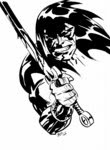Screengrab - "Better to be judged by twelve people than carried by six."

James Gray's third film as writer-director, "We Own the Night" feels generally a little too familiar. It covers territory audiences know well from a clutch of other films - New York Cops hunting down a drug ring, a man caught between friends and family, loyalty, violence, the dark streets of the American city in the past three decades, guilt, justice, revenge. You've seen it all before. You've seen it in the last year or two, in fact. You've seen "American Gangster" or "The Departed." "We Own the Night" is like a younger brother to those two films - its stars are less starry, its director less of a name, its budget and running time obviously less inflated. But Gray is hungrier than Ridley Scott or Martin Scorsese, and all three of his films so far - the other two are "Little Odessa" and "The Yards" - are impressive and speak of a growing talent who may one day deliver a truly great film.
Gray is a true auteur - he wrote and directed each of his films, and they share his thematic concerns. He is interested in family, in violence, in guilt and responsibility. He is a gifted director. Each of the films is directed with a confidence and inventiveness that is beyond the likes of modern-day Scorsese or Scott. The problem seems to lie with his writing, which can be uneven. He writes some beautiful scenes - sparkling dialogue and powerful emotions brought to the surface, realistically and painfully - but also some real clunkers. The plotting - particularly in "We Own the Night" - can seem horribly second-hand and derivative. When in doubt, resort to violence, seems to be Gray's way. But his characters can ground the films with their painful dilemmas, each of them conflicted and agonised by their lives.
What is most distinctive is Gray's seriousness. Each of his films is sombre and darkly atmospheric, intent on its own little tragedy. "The Yards" seems bent on turning itself into a mini-"Godfather" with its seeming mission to look like a John Alton-shot film noir in colour and its operatic heights of tension and release. Indeed, each of his films is beautifully lensed, and Gray deserves praise for his classicism, his determination to shoot films uncorrupted by modern editing styles and lighting techniques. It gives his work a timeless look, warm and lived-in yet never shrinking from the grubbiness of the urban underbelly they observe. His skill as a director is most apparent in the impact each of his set-pieces delivers. "We Own the Night", for instance, delivers a couple of stunning scenes. The first, a deafening, bloody police raid on a drug factory in a tenement building, is preceded by an equally impressive build-up of tension as one character feels that exposure as a police mole is close. The second is a car chase along a highway in a rainstorm. Here Gray's cutting and shot choice is exemplary yet never predictable, keeping the scene exciting yet intimate, horrific and convincingly confusing as it is. The film's finale - a bracingly suspenseful and visceral pursuit on foot through a field of reeds - is another example of his gift for set-pieces, as is the central fist-fight in "The Yards", perhaps the most realistic ever put on film. He is adept at evoking clammy fear, the dread of discovery, the adrenaline of sudden violence, always a you-are-there feeling of inhabiting a scene, perhaps because his approach to such scenes is always fresh and different.
Despite all this the best scene in "We Own the Night" is the opening credits. I say "credits" altough there are none. The movie's title is only visible as part of a badge in one of the photos making up the opening photo montage. This montage is composed entirely of period photos of NYC police at work - and a few evocative crime scene shots - from the 70s or early 80s. These photographs tell their own vivid and intriguing tales, with the faces looking out from some of them, the perfectly captured moments of real life, real police, real criminals, drug paraphernalia. You can almost smell some of the rooms, the stink of sweat and cigarettes. The photos are all black & white, full of subtly textured greys, and reminiscent in many cases of the work of legendary crime scene photographer Weegee. An instrumental, loungey lite-jazz reading of "I'll Be Seeing You" by Jackie Gleason's Orchestra plays over the top, its elegiac sadness counterpointing the bleak starkness of some of the images. Its a strangely potent sequence, and a reminder of the unequivocal power of the still photograph to capture an instant. It sets an aesthetic standard the rest of the film has significant trouble reaching, though Gray and his excellent cast give it a good go.





Perhaps the truly great film I hoped for above will be his next, "Two Lovers", his first non-genre piece, which played to mixed reviews at Cannes last week. Though admittedly, the premise suggests that this may be the film where he does not allow himself the escape of any set-pieces...
Labels: film



0 Comments:
Post a Comment
<< Home